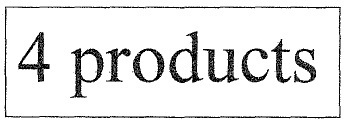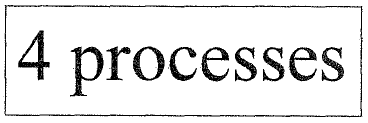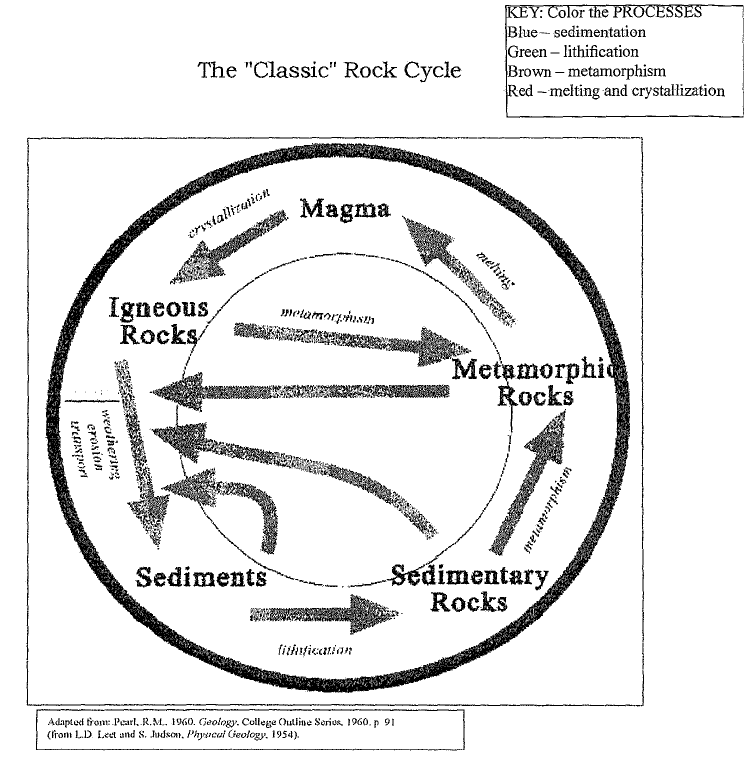The Rock Cycle
The Story
If you only can tell a little bit of a rock's story, if you are not skilled in recognizing rock types and don't know any rock names (think of them as characters of the story) at least tell the basic plot of the story that the rock tells. The plot is always the same theme... the rock cycle.
You can think of it as a journey...
You can think of it as a recycling factory ...
The rock came from there... Now it is here.... it will be going there.
You can think of it as a simple cycle ...
Process #1 made it a __ rock: The process #2 made it a ___ rock:
Then process #3 made it a __ rock again: Next Process #4 will....
You can think of it as cycles within cycles ...
A __ rock becomes a __ rock: which becomesn a __ rock: which
becomes a __ rock: which becomes a __ rock: which becomes...
You can think of it as a bicycle with the rock cycle in the crust and the mass and heat transfer in the interior
A __ rock gets recycled as a __ rock and then takes a differnt
path to become a __ rock. Then...
Your challenge is to figure out where a rock is in the rock cycle. Every rock is somewhere on the journey. Every rock is somewhere in the recycling process. Then you can tell the story of the rock's past and the rock's future. Then you are teaching earth science.
The uneven distribution of heat within the interior of the earth produces
convection and igneous rocks: it drives movements of the crustal plates:
collisions and spreading cause uplifts and downwarps differences in
topography result in erosion and deposition and....
The Rock Cyle ... Genevieve's way
FOUR products and FOUR processes
All the bedrock of Salt Lake County was made from earlier rocks that were:
- disintegrated into fragments (sediments) that then became consolidated into a new rock (sedimentary rock).
- were subjected to heat and pressure that transformed many of the minerals and welded them into a new rock (metamorphic rock).
- or were heated to such an extent that they melted, then cooled and recrystallized and formed a new rock (igneous rock).
Every rock is somewhere in the rock cycle. The story of the rock is the story of rock cycle: where the rock is now on the rock cycle, the path it took on the rock cycle to get to where it is now, and the path on the rock cycle it will take into the future.
The rock cycle can be illustrated in several ways. Here are four ways to describe the Tock cycle:
- 1) a simple cycle with way points and pathways {adapted: Prentice Hall).
- 2) Earth's recycling system (Earth Science Education).
- 3) the rock cycle as a journey (Earth Science Education), and
- 4) two cycles, one internal and one external (Dynamic Earth)
All these ways of telling the story have the same theme:

There are four products:
- sediments
- sedimentary rocks
- metamorphic rocks
- igneous rocks.
There are four processes:

- Sedimentation (weathering, erosion, and transport)
- Lithification (making sediments firm and coherent)
- Metamorphism (altering the physical and chemical characteristics of minerals of rocks)
- Melting and crystallization.
The "Classic" Rock Cycle

This is the "simple" rock cycle found in many texts. Your students may be expected to understand it. Note the one-way paths (follow the arrows). This version of the rock cycle conveys the unending, cyclic nature of the rock cycle. Rocks can go round and round and round the cycle, as long as they follow the arrows. Note how this version of the rock cycle has five processes and five products.


The story of a rock can be told as the story of a journey. The rock was at a rock type and then took a path (a rock process) to another rock type. The rock will continue on a path (a rock process) until it becomes another rock type. Reminder: note theone-way paths.

- Key: Color the PROCESSES
- BLUE-sedimentation
- GREEN-lithification
- BROWN- metamorphism
- RED- menting and crystalization

- Key: Color the PROCESSES
- BLUE-sedimentation
- GREEN-lithification
- BROWN- metamorphism
- RED- menting and crystalization
SUMMARY
When you teach the Rock Cycle
you teach science.
Study each of these diagrams and use whichever ones help you understand the rock cycle the best.
The game of rock identification is to figure out where the rock is on the rock cycle, where its been, and where its going.
1) Jump onto the cycle where it says metamorphic rocks.
Find the place on the cycle that says "metamorphic rock. " This means metamorphic bedrock
2) What is the immediate past history of this rock? Where has the rock
been on the rock cycle?
Note the arrows leading to "metamorphic rock:
Note how the arrows are one-way paths ... from one rock type via a process to the next rock type.
The arrows are the processes.
The process that results in metamorphic bedrock is called metamorphism.
Three paths lead to metamorphic bedrock:
• From sedimentary rock via metamorphism,
• Fram igneous rock via metamorphism, and
• (and a loop that ss not always show , From metamorphic rock to metamorphic rock via
metamorphism ..
3) What will become of this rock? Where can it go on the rock cycle?
Three paths leave the metamorphic rock stop of the rock cycle:
• the weatheri.ng pathway to "sediments"
• the melting and crystallization pathway to "igneous rocks"
• the lnetamorphosis pathway to "metarnorphic rocks."
lVote: m.etalnorphic rocks cannot talee a direct path to "sedimentary rocks."
This is the story of "metamorphic bedrock."
This is the story of the metamorphic bedrock at the mouth of Little Cottonwood Canyon, of much of the bedrock of Antelope Island, and of some difficult-tofind outcrops of metamorphic bedrock on the northern boundary of Salt Lake County and Davis County.